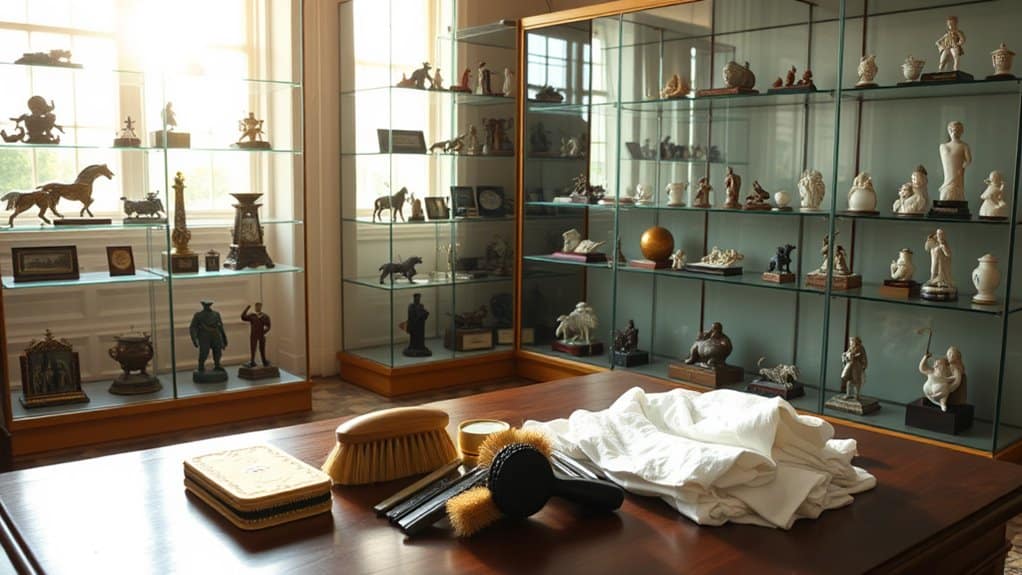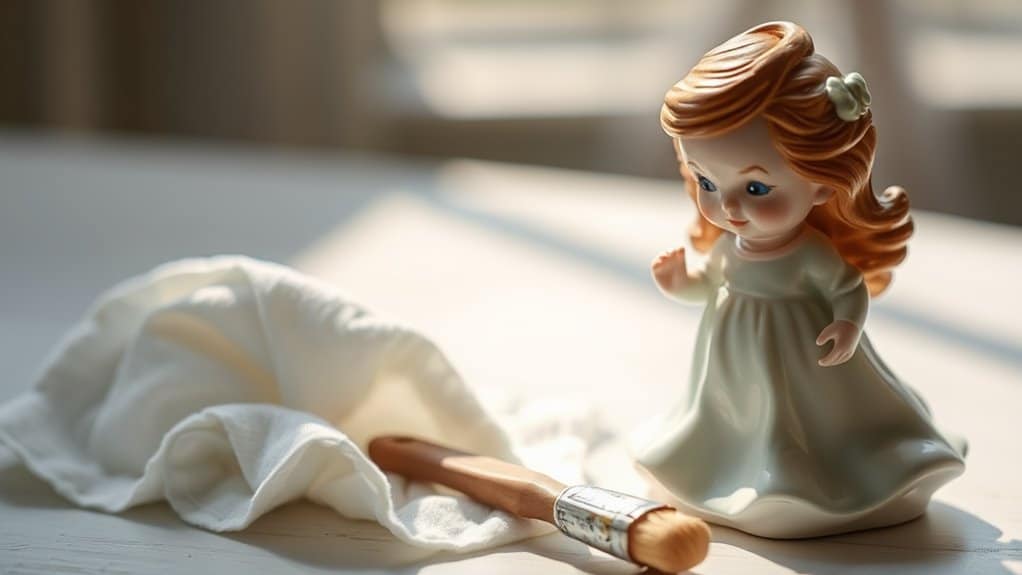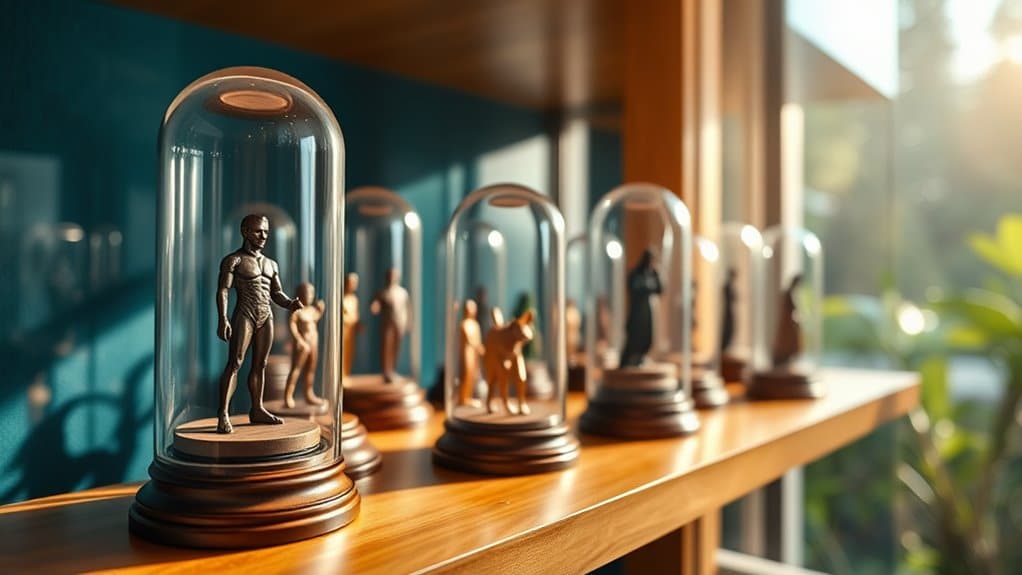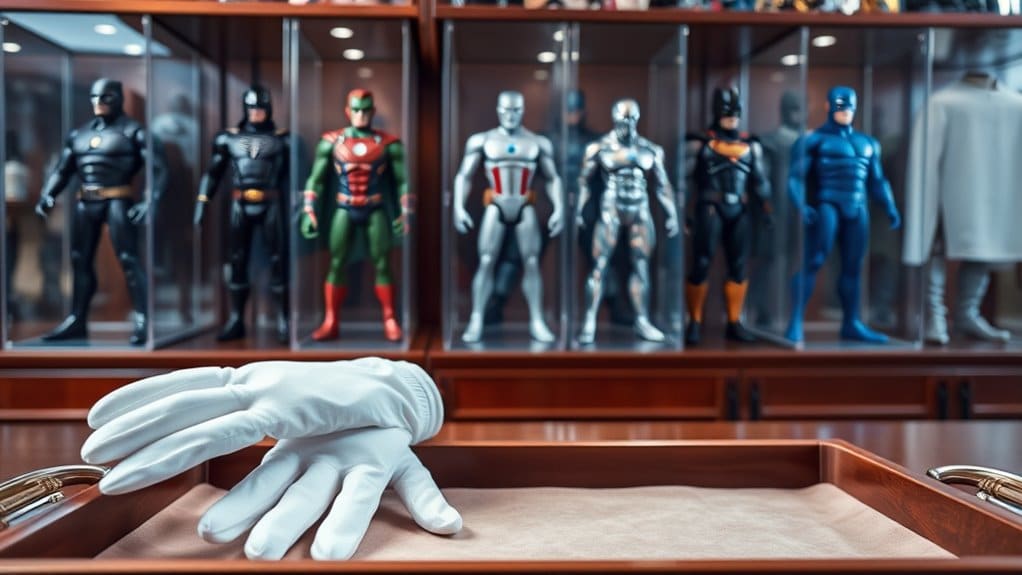To ideally care for your collectibles, choose a storage space that fits your items and keeps them secure. Maintain a stable temperature of 65-70°F and humidity levels between 40-50%. Use dehumidifiers, seal cases, and opt for acid-free materials to protect against dust and moisture. Handle items with care using gloves and clean them gently with pH-neutral solutions. Catalog your collection meticulously. Curious to know more, there's plenty to uncover in effective collectible care.
Choosing the Right Storage Space
When you're safeguarding your valuable collectibles, selecting the right storage space is essential. You need to take into account factors like size, accessibility, and security. First, make sure your space is large enough to accommodate your items without crowding. Overcrowding can lead to damage, so plan for additional room if your collection grows.
Next, think about accessibility. You should be able to easily reach and manage your collectibles, especially if you frequently rotate or display them. Choose a location that's convenient and allows for regular check-ins.
Finally, prioritize security. Use locks or secure containers to protect against theft or accidental damage. A well-chosen space will preserve your items' condition and value, giving you peace of mind knowing your treasures are safe.
Controlling Temperature and Humidity
Properly controlling temperature and humidity is essential for preserving your collectibles' integrity. High temperatures can cause materials to expand, warp, or become brittle, while low temperatures might make them too rigid. Aim to maintain a stable temperature around 65-70°F (18-21°C). Humidity can wreak havoc too. High humidity promotes mold and mildew, damaging paper, wood, and textiles. Meanwhile, low humidity can dry out and crack organic materials like leather and wood. Keep humidity levels between 40-50% for ideal conditions. Use a hygrometer to monitor levels and a dehumidifier or humidifier to adjust them as needed. Don't place collectibles near heat sources or in direct sunlight, as these can cause fluctuations in temperature and humidity, compromising their longevity.
Protecting Against Dust and Debris
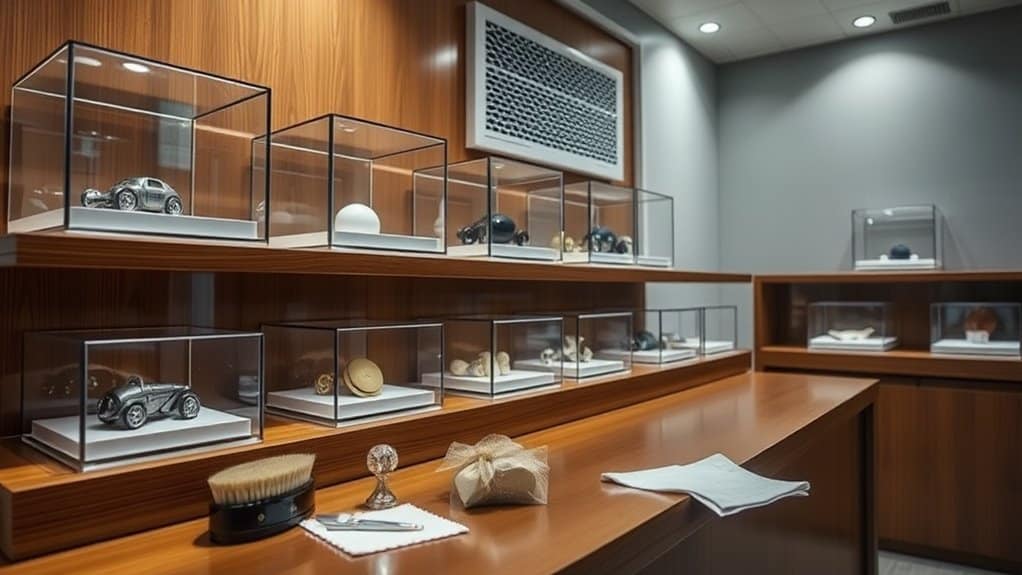
To keep your collectibles in pristine condition, you need to protect them from dust and debris. Consider using effective dust prevention techniques like sealing display cases and choosing the right protective covers. Regular cleaning practices will help guarantee your treasures remain untouched by unwanted particles.
Effective Dust Prevention Techniques
Although often underestimated, dust and debris pose considerable threats to the longevity of your collectibles. To effectively prevent dust accumulation, start by choosing a dedicated display area that's away from high-traffic zones, reducing the chance of airborne particles settling. Regularly clean the display area using a microfiber cloth or a soft brush to gently remove dust. Keep windows closed and use air purifiers to minimize dust entry. Additionally, maintain a stable humidity level, as fluctuating conditions can attract more dust.
It's also a good idea to establish a cleaning schedule. Weekly or bi-weekly dusting can make a huge difference. Vacuum floors frequently to reduce dust circulation. By implementing these techniques, you'll greatly enhance the protection of your treasured items.
Choosing Protective Covers
When it comes to safeguarding your collectibles from dust and debris, choosing the right protective covers is essential. Start by selecting covers made from acid-free materials to prevent damage over time. Clear plastic covers provide a great option, as they allow visibility while keeping dust at bay. Guarantee the covers fit snugly, leaving no gaps for particles to sneak in. Remember, not all covers are created equal; opt for those specifically designed for your type of collectible, whether it's books, figurines, or artwork. You might also consider fabric covers for items sensitive to humidity. For added protection, keep your covered collectibles in a controlled environment away from direct sunlight and high humidity. Taking these steps guarantees your treasures remain pristine for years.
Regular Cleaning Practices
Dust can be a relentless adversary when preserving your collectibles. It settles quietly, yet damages over time, dulling surfaces and infiltrating crevices. To combat this, establish a regular cleaning routine. Use a soft, lint-free cloth or a microfiber duster to gently remove dust without scratching surfaces. For intricate items, a soft-bristled brush can help reach tight spots.
Avoid using harsh chemicals; they can strip finishes and harm materials. If necessary, slightly dampen your cloth with water or a mild cleaner that's safe for the specific material. Consistency is key—clean your collectibles regularly to prevent buildup.
Ensure your storage area is well-ventilated and free from excessive humidity, which can attract more dust. By staying diligent, you'll keep your treasures looking pristine.
Utilizing Proper Shelving and Display Cases
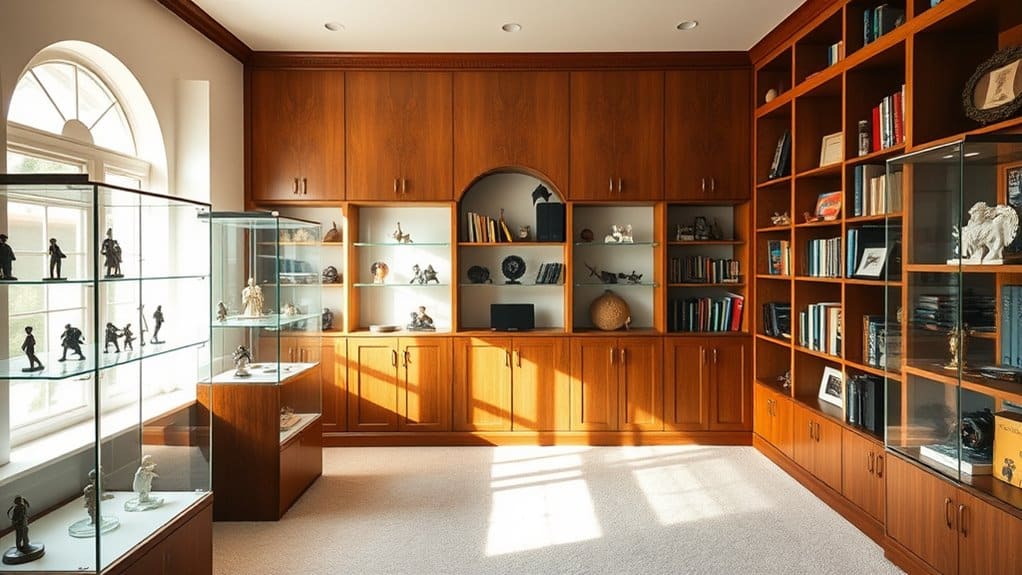
Proper shelving and display cases are essential for showcasing your collectibles while ensuring their preservation. When selecting shelves, choose sturdy materials like wood or metal to support the weight of your treasures. Adjustable shelves offer flexibility, allowing you to accommodate items of various sizes. Display cases with glass doors provide a protective barrier against dust and accidental damage, keeping your collectibles in pristine condition.
Ensure that the shelves and cases are securely anchored to prevent tipping, especially in high-traffic areas. Arrange items thoughtfully, leaving enough space between them to avoid overcrowding. This not only highlights individual pieces but also reduces the risk of scratches and damage. By investing in quality shelving and display cases, you'll preserve your collectibles and enjoy them for years.
Avoiding Direct Sunlight Exposure
Although sunlight can beautifully illuminate your space, it is crucial to keep your collectibles out of direct sunlight to prevent damage. Sunlight can cause fading, discoloration, and even warping over time, robbing your treasured items of their original beauty. To protect them, position display cases away from windows or use UV-protective film on glass surfaces. Consider installing curtains or blinds to control light exposure.
Think about rotating your items regularly, ensuring they don't sit in one spot for too long, absorbing harmful rays. If possible, utilize LED lighting for your displays, as they emit less heat and UV light compared to traditional bulbs. By taking these precautions, you'll preserve the integrity and value of your collectibles for years to come.
Regularly Inspecting for Pests and Mold
Beyond protecting your collectibles from sunlight, guaranteeing they're safe from pests and mold is equally important. You should conduct regular inspections to catch any issues early. Pests like insects can damage your items, while mold thrives in damp, dark spaces, potentially ruining delicate materials. Check for signs of infestation or mold growth, such as small holes, droppings, or musty odors. Make sure to inspect less obvious areas like the backs of frames and inside storage boxes.
To prevent these problems, maintain a clean and dry environment. Keep humidity levels low with a dehumidifier if necessary, and guarantee good air circulation. Cleaning your storage area regularly will help reduce the risk of pests and mold taking hold. Being vigilant helps preserve your collection's integrity.
Using Acid-Free Materials for Storage
One essential step in safeguarding your collectibles is using acid-free materials for storage. Acid-free materials prevent harmful chemical reactions that cause deterioration over time. When you store items like paper, photographs, or textiles, using acid-free boxes, folders, or sleeves keeps them safe from yellowing and brittleness. Acid-free materials are designed to maintain a neutral pH, ensuring your treasures aren't exposed to damaging acids that might be present in regular storage options.
When selecting storage solutions, look for products labeled as "acid-free" or "archival quality." These materials are specifically engineered to protect sensitive items. Always store your collectibles in a cool, dry place, as humidity and temperature fluctuations can accelerate damage. With the right materials, your collectibles will remain in pristine condition for years to come.
Implementing a Gentle Cleaning Routine
While using acid-free materials is essential for preserving your collectibles, implementing a gentle cleaning routine is equally important to maintain their appearance and longevity. First, gather soft, lint-free cloths and mild, pH-neutral cleaning solutions. Avoid harsh chemicals that could damage delicate surfaces. Test the cleaner on a small, inconspicuous area first to verify it won't harm the item.
Dust your collectibles regularly with a soft brush or microfiber cloth to prevent dirt buildup. For more thorough cleaning, lightly dampen your cloth with the cleaning solution and gently wipe the surface. Don't forget to dry the item immediately to avoid moisture damage.
Consistent, careful cleaning not only keeps your collectibles looking their best but also extends their lifespan. Stay patient and attentive to detail.
Handling Collectibles With Care
When handling your collectibles, always guarantee your hands are clean to prevent transferring oils or dirt. Consider using protective gloves to add an extra layer of safety, and remember to avoid direct contact whenever possible. These steps help maintain the item's condition and value over time.
Clean Hands Required Always
Imagine holding a delicate, century-old coin or a pristine comic book that's worth a small fortune. You wouldn't want to damage these treasures with dirty hands, would you? Clean hands are essential when handling collectibles. Oils, dirt, and grime from your skin can tarnish surfaces, stain pages, or degrade materials. Here's what you should do:
- Wash your hands thoroughly with soap and water before touching any collectible.
- Dry your hands completely to prevent moisture transfer.
- Avoid lotions and creams that leave residues on your skin.
- Handle items carefully, using fingertips rather than palms to minimize contact.
Use Protective Gear
Protective gear is your best friend when handling valuable collectibles. It minimizes the risk of accidental damage and keeps your cherished items in pristine condition. Start by wearing gloves—preferably cotton or nitrile—to prevent oils and dirt from transferring to your collectibles. These gloves provide a protective barrier that guarantees your items remain untouched by harmful residues.
Next, consider using safety glasses. They shield your eyes from dust or small particles, which may become airborne during handling or cleaning. You should also wear a dust mask if you're dealing with items that might release particles, guaranteeing your collectibles stay free from contaminants.
Avoid Direct Contact
While protective gear forms the first line of defense, handling collectibles with care means avoiding direct contact whenever possible. Touching collectibles with bare hands can transfer oils and dirt, which might damage them over time. Instead, use tools and techniques that minimize direct contact. Consider these tips to help preserve the integrity of your treasures:
- Use clean, dry cloths or padded supports to move items safely.
- Employ tools like tweezers or tongs for smaller, delicate pieces.
- Consider display cases with UV protection to reduce handling needs.
- Rotate displays carefully to minimize touching and potential for accidents.
Cataloging and Documenting Your Collection
To maintain the value and organization of your collectibles, start by cataloging and documenting each item meticulously. Create a detailed inventory that includes descriptions, purchase dates, and any notable features. Use clear photographs to capture each item's condition, noting any imperfections. This visual record will help if you ever need to verify authenticity or value.
Next, assign a unique identification number to each item for easy reference. Digital tools like spreadsheets or specialized software can streamline this process, allowing you to categorize by type, era, or value. Be certain to back up your records regularly to prevent data loss.
Keep physical and digital copies of any provenance documents, certificates, or receipts. This guarantees you have all necessary information at hand for insurance or resale purposes.
Frequently Asked Questions
How Can I Insure My Collectible Items for Their Full Value?
To insure your collectible items for their full value, contact a professional appraiser for an accurate valuation. Then, consult with an insurance provider specializing in collectibles to find a policy that covers their full worth.
What Should I Do in Case of Accidental Damage to Collectibles?
Did you know 30% of collectors experience accidental damage annually? If it happens to you, document everything immediately. Take photos, notify your insurer, and seek professional restoration to maintain your collection's value and integrity.
Are There Any Apps for Tracking Collectible Market Values?
You can use apps like Collectors or PriceGuide to track collectible values. They offer real-time market data and let you manage your collection's worth easily. You'll find updates and alerts to make informed selling decisions.
How Do I Determine the Authenticity of a Collectible Item?
To determine a collectible's authenticity, research its background, check for official markings, and consult experts or trusted online communities. Use authentication services when needed, and always compare with verified examples to guarantee you're making informed decisions.
What Are Some Common Signs of Fake or Counterfeit Collectibles?
Spotting fakes is like finding a needle in a haystack! Examine details meticulously—look for inconsistent logos, poor craftsmanship, or unusual materials. Trust your gut; if something feels off, it's probably not genuine.
At a Glance
You've initiated a journey of love and preservation for your cherished collectibles. By choosing the right storage and minding the elements, you're ensuring they age gracefully. Shield them from dust's embrace, and let them bask in gentle light, not the sun's harsh glare. With tender cleaning and careful handling, you're giving them the red-carpet treatment. Documenting the collection adds a touch of elegance, ensuring their stories are told for generations.

